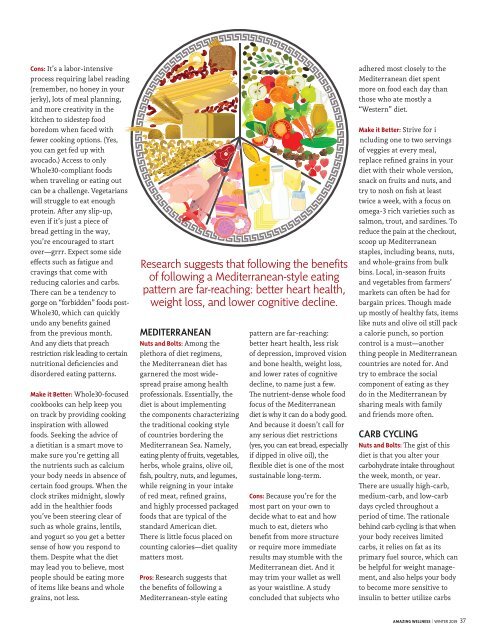Create successful ePaper yourself
Turn your PDF publications into a flip-book with our unique Google optimized e-Paper software.
Cons: It’s a labor-intensive<br />
process requiring label reading<br />
(remember, no honey in your<br />
jerky), lots of meal planning,<br />
and more creativity in the<br />
kitchen to sidestep food<br />
boredom when faced with<br />
fewer cooking options. (Yes,<br />
you can get fed up with<br />
avocado.) Access to only<br />
Whole30-compliant foods<br />
when traveling or eating out<br />
can be a challenge. Vegetarians<br />
will struggle to eat enough<br />
protein. After any slip-up,<br />
even if it’s just a piece of<br />
bread getting in the way,<br />
you’re encouraged to start<br />
over—grrr. Expect some side<br />
effects such as fatigue and<br />
cravings that come with<br />
reducing calories and carbs.<br />
There can be a tendency to<br />
gorge on “forbidden” foods post-<br />
Whole30, which can quickly<br />
undo any benefits gained<br />
from the previous month.<br />
And any diets that preach<br />
restriction risk leading to certain<br />
nutritional deficiencies and<br />
disordered eating patterns.<br />
Make it Better: Whole30-focused<br />
cookbooks can help keep you<br />
on track by providing cooking<br />
inspiration with allowed<br />
foods. Seeking the advice of<br />
a dietitian is a smart move to<br />
make sure you’re getting all<br />
the nutrients such as calcium<br />
your body needs in absence of<br />
certain food groups. When the<br />
clock strikes midnight, slowly<br />
add in the healthier foods<br />
you’ve been steering clear of<br />
such as whole grains, lentils,<br />
and yogurt so you get a better<br />
sense of how you respond to<br />
them. Despite what the diet<br />
may lead you to believe, most<br />
people should be eating more<br />
of items like beans and whole<br />
grains, not less.<br />
Research suggests that following the benefits<br />
of following a Mediterranean-style eating<br />
pattern are far-reaching: better heart health,<br />
weight loss, and lower cognitive decline.<br />
MEDITERRANEAN<br />
Nuts and Bolts: Among the<br />
plethora of diet regimens,<br />
the Mediterranean diet has<br />
garnered the most widespread<br />
praise among health<br />
professionals. Essentially, the<br />
diet is about implementing<br />
the components characterizing<br />
the traditional cooking style<br />
of countries bordering the<br />
Mediterranean Sea. Namely,<br />
eating plenty of fruits, vegetables,<br />
herbs, whole grains, olive oil,<br />
fish, poultry, nuts, and legumes,<br />
while reigning in your intake<br />
of red meat, refined grains,<br />
and highly processed packaged<br />
foods that are typical of the<br />
standard American diet.<br />
There is little focus placed on<br />
counting calories—diet quality<br />
matters most.<br />
Pros: Research suggests that<br />
the benefits of following a<br />
Mediterranean-style eating<br />
pattern are far-reaching:<br />
better heart health, less risk<br />
of depression, improved vision<br />
and bone health, weight loss,<br />
and lower rates of cognitive<br />
decline, to name just a few.<br />
The nutrient-dense whole food<br />
focus of the Mediterranean<br />
diet is why it can do a body good.<br />
And because it doesn’t call for<br />
any serious diet restrictions<br />
(yes, you can eat bread, especially<br />
if dipped in olive oil), the<br />
flexible diet is one of the most<br />
sustainable long-term.<br />
Cons: Because you’re for the<br />
most part on your own to<br />
decide what to eat and how<br />
much to eat, dieters who<br />
benefit from more structure<br />
or require more immediate<br />
results may stumble with the<br />
Mediterranean diet. And it<br />
may trim your wallet as well<br />
as your waistline. A study<br />
concluded that subjects who<br />
adhered most closely to the<br />
Mediterranean diet spent<br />
more on food each day than<br />
those who ate mostly a<br />
“Western” diet.<br />
Make it Better: Strive for i<br />
ncluding one to two servings<br />
of veggies at every meal,<br />
replace refined grains in your<br />
diet with their whole version,<br />
snack on fruits and nuts, and<br />
try to nosh on fish at least<br />
twice a week, with a focus on<br />
omega-3 rich varieties such as<br />
salmon, trout, and sardines. To<br />
reduce the pain at the checkout,<br />
scoop up Mediterranean<br />
staples, including beans, nuts,<br />
and whole-grains from bulk<br />
bins. Local, in-season fruits<br />
and vegetables from farmers’<br />
markets can often be had for<br />
bargain prices. Though made<br />
up mostly of healthy fats, items<br />
like nuts and olive oil still pack<br />
a calorie punch, so portion<br />
control is a must—another<br />
thing people in Mediterranean<br />
countries are noted for. And<br />
try to embrace the social<br />
component of eating as they<br />
do in the Mediterranean by<br />
sharing meals with family<br />
and friends more often.<br />
CARB CYCLING<br />
Nuts and Bolts: The gist of this<br />
diet is that you alter your<br />
carbohydrate intake throughout<br />
the week, month, or year.<br />
There are usually high-carb,<br />
medium-carb, and low-carb<br />
days cycled throughout a<br />
period of time. The rationale<br />
behind carb cycling is that when<br />
your body receives limited<br />
carbs, it relies on fat as its<br />
primary fuel source, which can<br />
be helpful for weight management,<br />
and also helps your body<br />
to become more sensitive to<br />
insulin to better utilize carbs<br />
AMAZING WELLNESS | WINTER <strong>2019</strong> 37

















